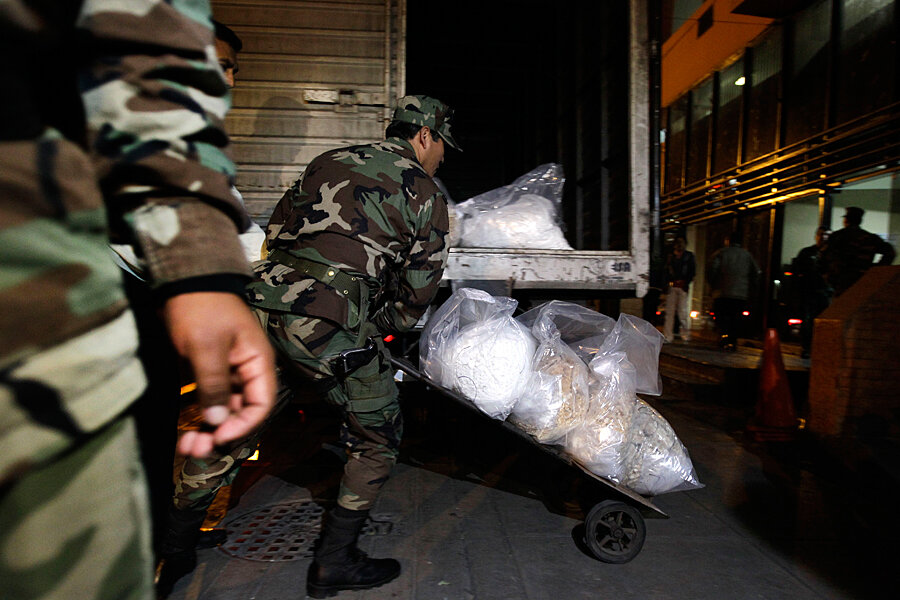Will Peru start shooting down suspected drug planes (again)?
Loading...
| LIMA, Peru
Peruvian police officers recently pulled off a major drug bust, seizing 325 kilograms (715 pounds) of cocaine ready for shipment out of the central jungle.
The Mar. 7 operation was significant, representing nearly one-third of the cocaine seized so far this year in Peru. But authorities were even more pleased with the capture of a small plane for smuggling the drugs to neighboring Bolivia and, from there, to parts unknown.
In the 1980s and 1990s, cocaine-ferrying planes dotted Peru's skies. Now they're back: the US State Department says small planes are now the “primary method of transporting cocaine” out of the country, replacing sea transport. In its annual report on narcotics released earlier this month, the State Department estimated that upward of 180 metric tons were exported this way in 2013.
But how to stop these flights is a vexed issue. A significant number of countries in Latin America, most recently Venezuela in late 2013 and Honduras in January 2014, have enacted laws allowing local air forces to shoot down suspected drug planes over their territory.
Peru has a similar law, but it has been suspended since April 2001, when the Peruvian Air Force, accompanied by a CIA support plane, mistakenly shot down an aircraft carrying missionaries. A US Baptist missionary from Michigan, Veronica Bowers, and her adopted infant daughter were killed. Her husband, young son, and the pilot survived.
Thirteen years on, some Peruvian lawmakers argue the time has come to reinstate the shoot-down policy.
“Peru is the only country that does nothing to stop irregular flights over its national territory," says Congressman Carlos Tubino, a retired general. "The policy of keeping the Air Force out of the fight against drugs has been an absolute failure and the results are there for anyone to see, but no one wants to make a decision."
Tubino acknowledges that the incident with the missionary plane was a tragedy, but he says that the policy should be revived and last November authored legislation to that effect. He's now pushing for the congressional defense committee to approve his bill and send it to the floor for a vote.
Peru is currently the world’s largest grower of coca – from which cocaine is extracted – and cocaine producer. Coca plants cover close to 150,000 acres, according to the UN Office on Drugs and Crime.
President Ollanta Humala’s government has made strides in dealing with the coca-cocaine problem, eradicating 93,900 acres of coca, which would have yielded 290 metric tons of cocaine, in the past two years. This year's eradication target for this year is about 74,000 acres.
Inaction in tackling the drug flights means Peru will continue waging an “indirect war against drug trafficking that is focused on eradication and stopping precursor chemicals used to make cocaine, but without an interdiction strategy,” says Tubino, an opposition politician. “It is simply inexplicable.”
Alternative options
Peru lags its neighbors in cocaine interdictions, according to local and international reports. In 2013, Peru seized approximately 8 percent of the cocaine it produced, while Bolivia was above 20 percent and Colombia topped 40 percent.
But Carmen Masias, head of Peru's anti-drug agency, DEVIDA, says a revived shoot-down policy isn't the way to go. Ms. Masias prefers a non-lethal strategy that includes tearing up clandestine runways and using police aircraft to force planes to land, which is how the Mar. 7 operation unfolded. DEVIDA says that 110 clandestine airstrips were destroyed in 2013, with another 20 eliminated in the first two months of this year.
“We have made progress with [coca] eradication and development, including alternative crops. We have had important success, but recognize that the challenge is enormous,” Masias says.
Peru's government recently turned its attention to coca production in a a Maryland-size stretch of jungle known as the VRAEM, named after valleys formed by three rivers. Since 2003, the area has been under a state of emergency because of terrorist activities by remnants of the Shining Path and has an estimated 49,000 acres of coca production.
Eradication has never occurred in most of the zone, but this year the government wants to tear up 39,500 acres manually. Peru, unlike Colombia, does not allow aerial spraying for eradication so plants are yanked out using shovels and picks.
As Peru debates the merits of shooting down drug planes, Tubino supports extending eradication to the VRAEM. Not to do so “would be like extending the welcome mat to drug cartels," he says.







